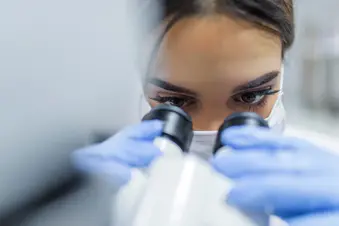
Genomic testing looks at the genes in your cancer, to help your doctor make more informed decisions about your disease and match you to the right treatment. These tests can also be useful if your cancer hasn't responded to the treatment you've been on, or if it has come back.
The type of genomic testing your doctor does is different from the DNA tests that you can buy online through companies like Ancestry or 23andMe. These consumer-based tests give you an overview of your inherited traits and how your DNA might affect your health. They can't help your doctor diagnose or treat your cancer. The genomic tests your doctor orders provide specific information about your cancer cells and the best ways to treat your cancer.
To do a genomic test, your doctor will first need a sample of your blood or tissue from your cancer. That sample will go to a lab, which will test it for certain gene changes that affect how your cancer grows and how it might respond to treatment.
Getting a Sample
To get a sample of tissue from your cancer, your doctor will do a biopsy. It's already a standard part of the process doctors use to diagnose cancer.
During this test, your doctor removes a small piece of tissue or cells from your tumor with a needle, scalpel, or other tool. That sample goes out to a lab. A biopsy can show whether the cells in the sample are normal or cancerous. The lab can also test for changes called mutations in your cancer's DNA.
If you have a blood cancer such as leukemia or lymphoma, or your tumor is in an area where your doctor can't easily reach it to do a biopsy, you might have a "liquid biopsy" instead. Cancer cells shed tiny pieces of their DNA into the blood. A liquid biopsy looks for these fragments of DNA in a blood sample, which your doctor will get from you during a blood draw.
Genomic testing for blood cancers like leukemia or multiple myeloma may use a sample from your bone marrow -- the spongy tissue inside your bones where your body makes new blood cells. Your doctor will use a needle to remove a sample of the tissue or liquid from inside your bone marrow.
Your doctor might also take a sample of healthy cells from your blood, saliva, or skin. The lab can then compare the DNA from your healthy cells to the DNA from your cancer cells. This process can help to identify whether the gene mutations that caused your cancer happened during your lifetime. These are called somatic mutations, and they're different from the gene mutations you inherited from your parents.
Gene Sequencing
The next step in the process is to sequence your cancer's DNA. Your DNA is a long code made from strands of four units, called bases:
- Adenine (A)
- Cytosine (C)
- Guanine (G)
- Thymine (T)
Each one of these is paired up -- A with T and C with G. The order, or sequence, of these pairs contains the code, or instructions, for making the proteins your body needs to run. DNA sequencing tests look at the order of these pairs to find changes from normal that helps your cancer grow.
Since your genome contains about 3 billion base pairs, sequencing it would normally take a very long time. A new high-tech method called next-generation sequencing scans many pieces of DNA at once, to speed up the process and get the results to you and your doctor much more quickly.
Genomic sequencing can be done in different ways. Whole-exome sequencing looks at the parts of your genome that code for proteins. Whole-genome sequencing looks at all of the DNA in your cancer.
Another test counts the number of times that certain gene mutations show up in your cancer, which is called the tumor mutational burden. This test can help your doctor predict whether a group of drugs called immune checkpoint inhibitors will work for your cancer.
Your Genomic Test Results
Once the lab has tested your blood or tissue sample, your doctor will get back a report that lists all of the genetic changes in your cancer cells, and which targeted treatments might work against them. You and your doctor will discuss the results, and then decide what your next steps should be.
Show Sources
Photo Credit: E+ / Getty Images
SOURCES:
College of American Pathologists: "The 'Liquid' Biopsy."
Leukemia & Lymphoma Society: "Bone Marrow Tests."
Mayo Clinic: "Biopsy: Types of biopsy procedures used to diagnose cancer."
National Cancer Institute: "Biomarker Testing for Cancer Treatment," "Liquid Biopsy: Using Tumor DNA in Blood to Detect, Track, and Treat Cancer," "Next-Generation Sequencing," "Whole-Exome Sequencing."
National Human Genome Research Institute: "Direct-to-Consumer Genomic Testing," "Genetic Code," "Human Genome Project FAQ."
